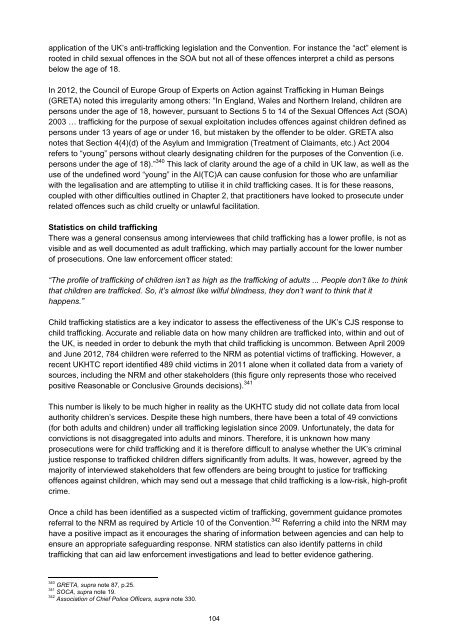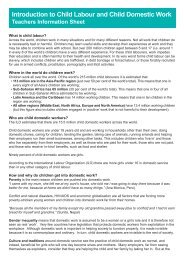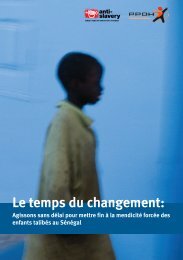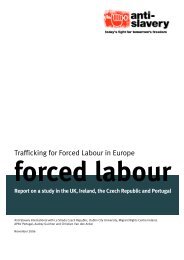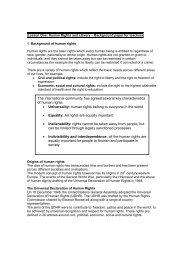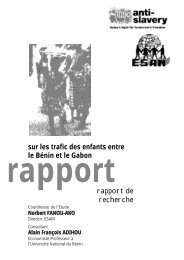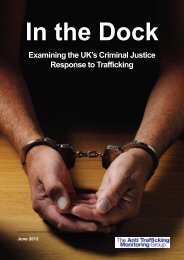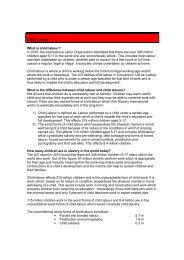In the Dock
Full report (1810.59KB) - Anti-Slavery International
Full report (1810.59KB) - Anti-Slavery International
You also want an ePaper? Increase the reach of your titles
YUMPU automatically turns print PDFs into web optimized ePapers that Google loves.
application of <strong>the</strong> UK’s anti-trafficking legislation and <strong>the</strong> Convention. For instance <strong>the</strong> “act” element isrooted in child sexual offences in <strong>the</strong> SOA but not all of <strong>the</strong>se offences interpret a child as personsbelow <strong>the</strong> age of 18.<strong>In</strong> 2012, <strong>the</strong> Council of Europe Group of Experts on Action against Trafficking in Human Beings(GRETA) noted this irregularity among o<strong>the</strong>rs: “<strong>In</strong> England, Wales and Nor<strong>the</strong>rn Ireland, children arepersons under <strong>the</strong> age of 18, however, pursuant to Sections 5 to 14 of <strong>the</strong> Sexual Offences Act (SOA)2003 … trafficking for <strong>the</strong> purpose of sexual exploitation includes offences against children defined aspersons under 13 years of age or under 16, but mistaken by <strong>the</strong> offender to be older. GRETA alsonotes that Section 4(4)(d) of <strong>the</strong> Asylum and Immigration (Treatment of Claimants, etc.) Act 2004refers to “young” persons without clearly designating children for <strong>the</strong> purposes of <strong>the</strong> Convention (i.e.persons under <strong>the</strong> age of 18).” 340 This lack of clarity around <strong>the</strong> age of a child in UK law, as well as <strong>the</strong>use of <strong>the</strong> undefined word “young” in <strong>the</strong> AI(TC)A can cause confusion for those who are unfamiliarwith <strong>the</strong> legalisation and are attempting to utilise it in child trafficking cases. It is for <strong>the</strong>se reasons,coupled with o<strong>the</strong>r difficulties outlined in Chapter 2, that practitioners have looked to prosecute underrelated offences such as child cruelty or unlawful facilitation.Statistics on child traffickingThere was a general consensus among interviewees that child trafficking has a lower profile, is not asvisible and as well documented as adult trafficking, which may partially account for <strong>the</strong> lower numberof prosecutions. One law enforcement officer stated:“The profile of trafficking of children isn’t as high as <strong>the</strong> trafficking of adults ... People don’t like to thinkthat children are trafficked. So, it’s almost like wilful blindness, <strong>the</strong>y don’t want to think that ithappens.”Child trafficking statistics are a key indicator to assess <strong>the</strong> effectiveness of <strong>the</strong> UK’s CJS response tochild trafficking. Accurate and reliable data on how many children are trafficked into, within and out of<strong>the</strong> UK, is needed in order to debunk <strong>the</strong> myth that child trafficking is uncommon. Between April 2009and June 2012, 784 children were referred to <strong>the</strong> NRM as potential victims of trafficking. However, arecent UKHTC report identified 489 child victims in 2011 alone when it collated data from a variety ofsources, including <strong>the</strong> NRM and o<strong>the</strong>r stakeholders (this figure only represents those who receivedpositive Reasonable or Conclusive Grounds decisions). 341This number is likely to be much higher in reality as <strong>the</strong> UKHTC study did not collate data from localauthority children’s services. Despite <strong>the</strong>se high numbers, <strong>the</strong>re have been a total of 49 convictions(for both adults and children) under all trafficking legislation since 2009. Unfortunately, <strong>the</strong> data forconvictions is not disaggregated into adults and minors. Therefore, it is unknown how manyprosecutions were for child trafficking and it is <strong>the</strong>refore difficult to analyse whe<strong>the</strong>r <strong>the</strong> UK’s criminaljustice response to trafficked children differs significantly from adults. It was, however, agreed by <strong>the</strong>majority of interviewed stakeholders that few offenders are being brought to justice for traffickingoffences against children, which may send out a message that child trafficking is a low-risk, high-profitcrime.Once a child has been identified as a suspected victim of trafficking, government guidance promotesreferral to <strong>the</strong> NRM as required by Article 10 of <strong>the</strong> Convention. 342 Referring a child into <strong>the</strong> NRM mayhave a positive impact as it encourages <strong>the</strong> sharing of information between agencies and can help toensure an appropriate safeguarding response. NRM statistics can also identify patterns in childtrafficking that can aid law enforcement investigations and lead to better evidence ga<strong>the</strong>ring.340GRETA, supra note 87, p.25.341SOCA, supra note 19.342Association of Chief Police Officers, supra note 330.104


